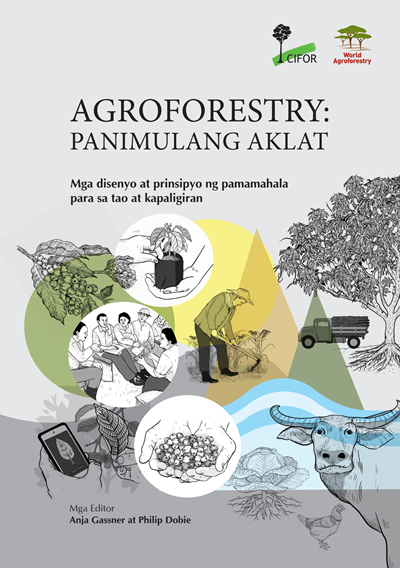Mga disenyo at prinsipyo ng pamamahala para sa tao at kapaligiran
Hindi mapagkakailang produktibo ang tradisyunal na pagsasaka. Ngunit may kapalit ang mataas na produksyon nito, tulad ng pagkaubos at pagguho ng lupa, pagiging marumi at pagkatuyo ng mga daluyan ng tubig, at sistema ng pagkain na nagdudulot ng 20–40% ng mga greenhouse gas emission. Maraming mga indibidwal ngayon ang sumasang-ayon na kailangan na nating baguhin ang sistema ng produksyon ng pagkain, kabilang na rito ang agrikultura. Bilang isang nature-based na pamamaraan ng produksyon at paggamit ng lupa, may ginagampanang mahalagang papel ang agroforestry sa mga pagbabagong ito. Hindi na bago ang agroforestry; isinasabuhay na ito ng mga magsasaka sa loob ng libu-libong taon, at kinikilala na rin ng mga siyentipiko mula pa noong 1970s bilang isang produktibo at ecologically sustainable na paraan ng pagsasaka at paggamit ng lupa. Ngunit ngayon, biglang nasa gitna ng yugto na ang agroforestry; isinusulong ito bilang isang pamamaraan sa paggamit ng lupa upang suportahan ang mitigasyon at adaptasyon (o pakikibagay) sa nagbabagong klima, biodiversity conservation, sustainable agriculture, at iba pang mga layunin. Inirerekomenda o ginagamit ito ng maraming organisasyon bilang isang tool para sa pagpapanumbalik ng mga ecosystem — hindi lamang sa agrikultura, kundi pati na rin sa mga landscape ng kagubatan.
Bagama’t hindi ito solusyon sa lahat ng problema, may malaking potensyal ang agroforestry na makapag-ambag sa pagkamit ng lahat ng mga layuning nabanggit sa itaas. Gayunpaman, hindi lamang patungkol ang agroforestry sa pagtatanim ng mga puno sa mga sakahan. Upang mapagtanto ang potensyal nito, kailangang maunawaan ng mga practitioner ang mga prinsipyo nito. Angagroforestry: Ang panimulang aklat ay isang gabay sa mga prinsipyo at konsepto ng agroforestry– at kung paano gamitin ang mga ito ng epektibo.
Also available in other languages:
- English: Agroforestry: A primer
- Spanish: Agroforestería: Una Guía
- Indonesian: Agroforestri: Sebuah Pengantar
DOI:
https://doi.org/10.5716/cifor-icraf/BK.33142Dimensions Nombre de citations:
Année de publication
2023
Auteurs
Langue
Tagalog
Mots clés
agroforestry, agroforestry systems, sustainable agriculture, land use, conservation, land rehabilitation, landscape conservation

















